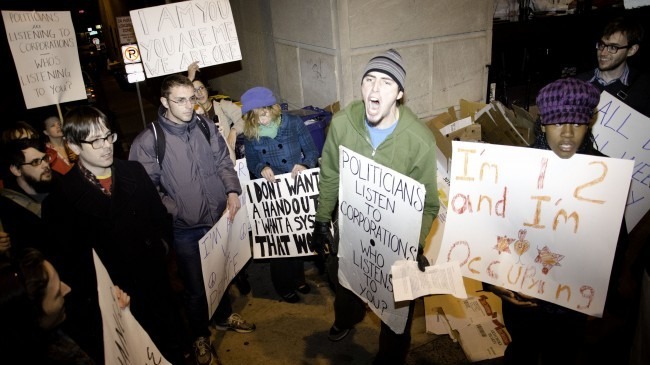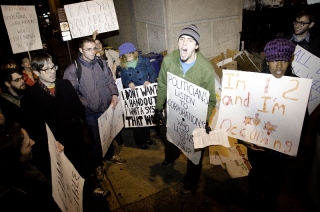By CARLO NASISSE – Photography Editor
The “Occupy” Movement has gained attention by its public protests across the nation, but lack of organization prevents further progress.
The rise of the Occupy Wall Street movement has presented our nation with an identity crisis. For centuries, the United States has been a nation led by the rich, for the rich.
Occupy Athens members chant, “We are the 99 percent,” as they march through Downtown Athens on Jan. 6. “Occupy Athens” is a regional branch of the international “Occupy” movement, which advocates for economic equality. Photo by Carlo Nasisse.
The “Occupy” movement presents a vision of economic equality. However, its survival is dependent on its ability to appeal to the American public.
At its core, the “Occupy” movement is based upon one idea: there is an unfair distribution of wealth that allows the rich to get richer and the poor to stay poor. Protesters cite statistics by a liberal anti-consumerist magazine, Adbusters, which suggest that one percent of the world controls the majority of the world’s wealth.
History shows us that no society in the history of human existence has been run by the majority of the population. It would appear that this sort of perfect democracy is impossible to achieve and that the “Occupy” movement is fighting a pattern in societies of a select few maintaining power over the majority. It is not unrealistic, however, to demand political reform in order to better balance the distribution of wealth.
“Occupy” has gotten people talking.
The massive and largely unorganized protests that have been broadcast and analyzed in great detail since the original “Occupy Wall Street” was formed, have led to a shift in the political dialogue of our nation’s leaders in much the same way that the emergence of the Tea Party shifted the tone of the Republican party.
This is most recently apparent in U.S President Barack Obama’s State Of The Union address as quoted in the Jan. 12 New York Times.
“You can call this class warfare all you want,” President Obama said of his call to create a more even economic playing field. “Most Americans would call that common sense.”
He characterized the choice as one between whether “a shrinking number of people do really well while a growing number of Americans barely get by” or his own vision “where everyone gets a fair shot.”
It is no coincidence that parts of Obama’s speech resembled the less articulate chants of “Occupy” protestors. While this is a positive shift, it still leaves power in the hands of many of the same leaders who are either a part of that one percent of wealthiest individuals or who appear on the payroll of the wealthy.
Right now “Occupy” represents an idea. Its proponents are united in a common feeling of injustice, however they are not united as a political faction. In order for the movement not to be absorbed and diluted by political parties, the different regional “Occupy” factions must change tactics in order to be more inclusive.
They need to quench the extreme left-wing participants who dilute the message of equality with cries of anarchy. The United States public will not be able to embrace “Occupy” in its current state. Protesting in the streets has gotten the attention of the nation. It has gained a population of supporters that are thrilled by the idea of standing up to authority, but his is not just an issue of the youth or those disenchanted with society; it is an issue for the entire American public.
“Occupy” will remain just an idea, just a feeling, just a small entry in future text books, unless it grows into its potential. It expresses the sentiments of the majority of the nation. It exposes a gross inequality and leaders who have done little to fix it.
To survive and act on these ideas, the “Occupy” movement must cater to a broader population. It has too much momentum at too crucial a moment in our nation’s progress to simply disappear like so many others that tried for equality.

